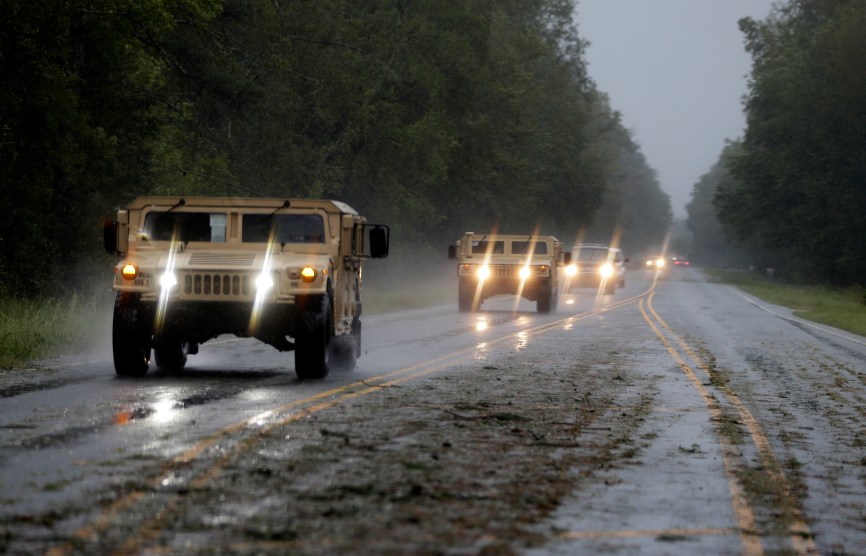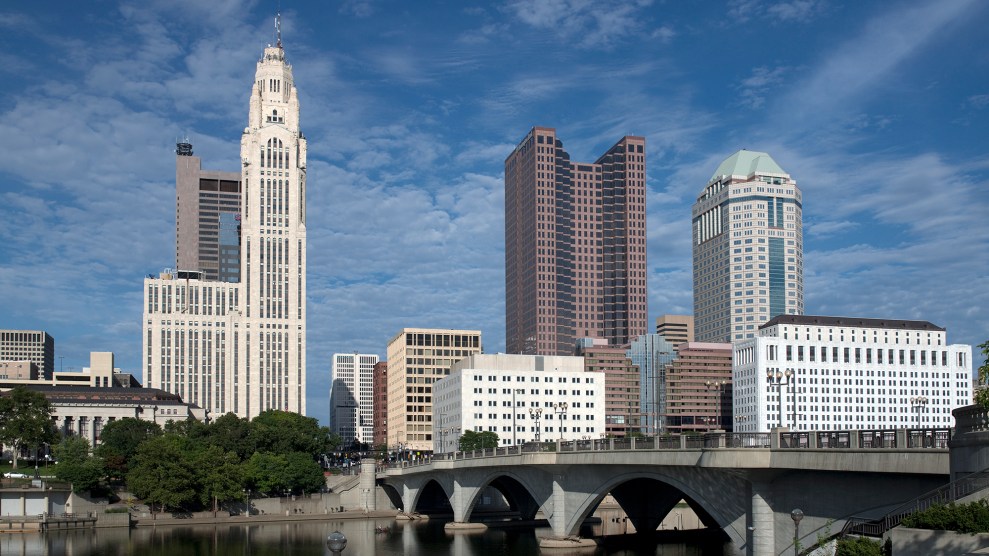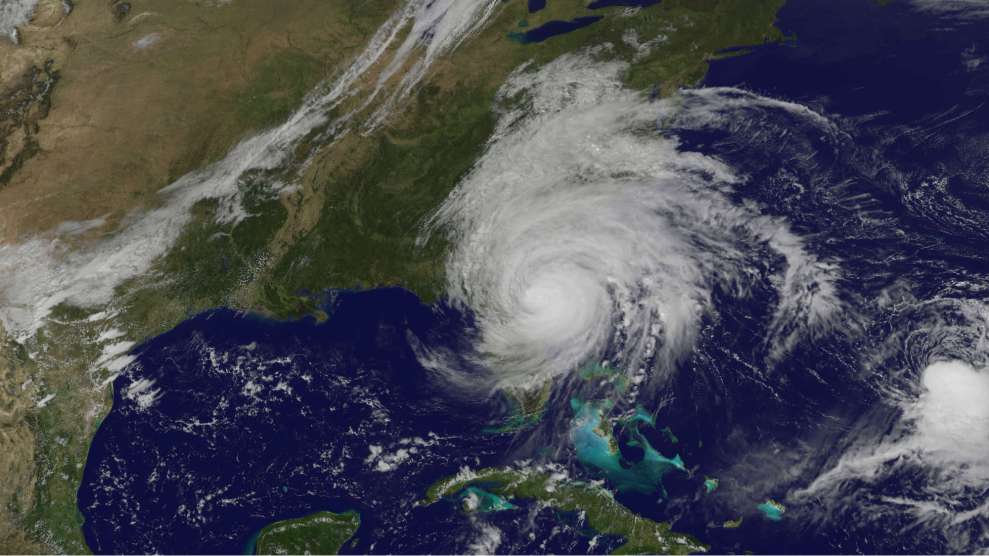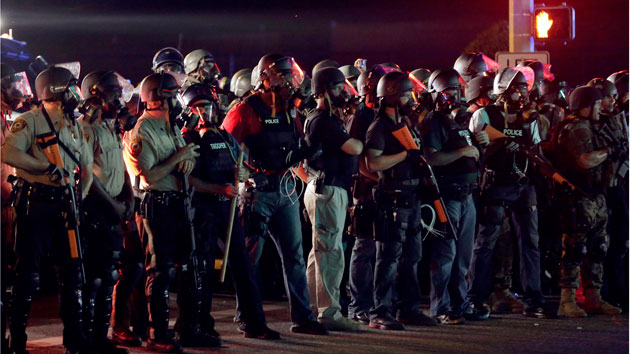
Military vehicles in North Carolina during Hurricane Matthew in 2016. Chuck Burton/AP
This story was originally published by Grist and is reproduced here as part of the Climate Desk collaboration.
Surfside Beach, South Carolina is on the frontlines of climate change. Rising sea levels have left daunting prospects for the city’s heavily tourism-dependent economy. In a population of 4,000, roughly half of the workforce is centered on the business of tourism: retail, food service, and entertainment. Five years ago, Hurricane Matthew destroyed the main tourism attraction, the Surfside Beach Pier. But in a region that has an 80 percent chance of being hit by a tropical storm each year, little federal aid has appeared to fund more climate-resistant infrastructure.
Instead, the small coastal town’s sliver of federal support against climate change will now be coming in the form of a military armored vehicle.
Last week, the Surfside Beach town council unanimously passed a motion to participate in the US Department of Defense’s “1033 Program.” The program, created in 1997, allows the US military to transfer weapons, gear, and vehicles once used in foreign wars to the possession of local law enforcement agencies. Over the program’s existence, more than 8,000 local law enforcement agencies have requested $7 billion worth of excess military equipment, everything from assault rifles to respirators.
According to reporting by WMBF News in South Carolina, police chief Kenneth Hofmann will use the program to procure several pieces of military equipment, including generators and armored tactical vehicles, such as “humvees” and “5-ton trucks” to “help the department when hurricanes come through.” Although the surplus program was not originally designed to mitigate the logistical problems created by severe weather events, municipalities across the country have increasingly named weather events as a justification for their inclusion in the program.
Over the last few years, hundreds of local agencies have cited “catastrophic storms, blizzards, and especially floods to justify why they ought to receive an armored vehicle,” according to a recent HuffPost investigation. But most departments, according to the investigation, rarely use the equipment for severe weather events.
In Johnson County, Iowa, for example, sheriffs have never used their military-grade “mine-resistant” armored vehicle to support residents during blizzards as it was originally procured for in 2014. Instead, it has been used to do things like disrupting Black Lives Matter protests and serving arrest warrants. Across the country, 1033 equipment has even been used to dispel protests against global warming causing pipeline projects, including during protests against the Dakota Access Pipeline.
Despite ample examples of misuse, last year Congress tweaked the 1033 Program to give priority access for armored vehicles to police and sheriffs’ departments that claimed to need them for disaster-related emergencies. Following the racial uprisings of 2020, a nationwide campaign spearheaded by the American Civil Liberties Union showed how local municipalities were abusing the equipment and turning communities into “war zones.” This fall, however, Congress whiffed at the chance to dramatically limit the program’s power.
It’s unlikely that an armored vehicle will be used to suppress racial protests in Surfside Beach, which is 95 percent white. But the continued use of the military program under the guise of combating climate change leaves many justice-oriented organizations worried. Advocates understand the need to prepare cities for climate disasters, but many contend regions will be better equipped and more safely prepared if these functions were transferred from police departments to dedicated disaster response networks that don’t require people equipped with guns or tanks, as outlined in various federal proposals such as President Joe Biden’s Civilian Climate Corps or aspects of the Green New Deal.
If anything, the 1033 program highlights the country’s weak protections against climate change, Lindsay Koshgarian, program director of the National Priorities Project, told Grist. “It shows that our funding priorities are all backward and it’s completely hobbling our ability to do anything about climate change,” she said. “When there are terrible hurricanes, when we need search and rescue operations, or when there are wildfires, we have military being deployed because we won’t fund other programs to deal with these things.”
Among other things, Koshgarian and other advocates point out the hypocrisy of the program, namely using equipment that helped fuel climate change to combat its impacts. The U.S. military is one of the largest polluters in history, emitting more greenhouse gasses than 140 countries combined, according to a 2019 study by researchers at Lancaster University in England. Not to mention, every year the U.S. spends more than $80 billion to position its military in oil-heavy regions to “protect” the global oil supply.
“We’re constantly told we can’t afford a Green New Deal, we can’t afford the modest half-measures for climate change that are in the Build Back Better Act,” she said. “But the Pentagon just got a $770 billion budget to fuel its petroleum guzzling.”
While it seems like the Build Back Better Act – the most comprehensive climate change spending plan in U.S. history – is not totally dead yet, other parts of the country’s climate policies need more attention, too. The 1033 program is only expected to grow after the withdrawal of the American troops from Afghanistan.
















